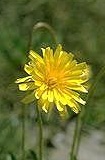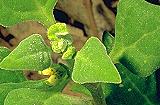|
[Front Page] [Features] [Departments] [SGAP Home Page] [Subscribe]

Bush Food Species for Temperate Regions
Sammy Ringer
This compilation has been obtained from a number of sources (and personal experience). It may serve as a starting point for those interested in experimenting with edible Australian plants.
Acacia spp: Wattle
Amongst them A.longifolia, A.decurrens, A.floribunda
It is well known that Acacia species are found throughout Australia, in almost every climatic and soil type. The seed of many are edible when finely ground and can be made into a damper - though the commercial viability of many is yet to be validated. The use of acacia leaf, bark and root in natural remedies is still an area of unrealised potential. Acacia melanoxylon is just one of the species suitable for farm forestry (cabinet timber) as well as bushfood production (though A.melanoxylon is not part of the 'A' team for wattle seed). A.sophorae, A.decurrens and A.floribunda are also ideal plantings for areas which experience heavy frosts.
Many Acacia can also play multiple roles in mixed plantings: - wind break, forage, timber and gum producer (noticeably A.decurrens).
Apium prostratum: Sea celery
This species is widely distributed in coastal areas of Australia and may be a "sleeper" in the bushfoods industry. It is related to the domestic celery and is a variable herb with broad or narrow divided leaves and a fairly celery-like taste. It was certainly eaten with gusto by early explorers and colonists. It prefers a damp, sunny position and will tolerate heavy frosts.
You don't see it on menus yet (or I certainly haven't!) but Tim Low tells us (in 'Wild Food Plants of Australia') that there is a giant Apium insulare found on Bass Strait Islands which could be worth investigating.
Native "Lilies"
These include Arthropodium spp (Mountain vanilla lily), Bulbine bulbosa (Bulbine lily), Dichopogon strictus and D.fimbriatus (Chocolate lily). They are tufted perennial plants with small lily-like flowers.
Although many members of the Lily family were eaten by the Aborigines, the small tubers of such plants as the Vanilla Lily and the Bulbine Lily are either bland or bitter to European taste and not likely to find their way into the mainstream. The chocolate smell of the flowers of Dichopogon is not reflected in the flavour of the tubers.
Microseris lanceolata: Murnong or Yam Daisy
  |
This was an important staple of the Kooris of Victoria but was decimated by stock. It is a small herbaceous plant with yellow daisy-like flowers. Once again, the carrot or radish shaped tuber has not yet gained much commercial interest.
The Murnong is quoted by Low as being one of the tastiest of the original staple foods and Baron Von Mueller was of the opinion it should be cultivated as a cold climate vegetable - but little has been done.
Photo: Australian National Botanic Gardens
Select the thumbnail image or plant name for a higher resolution image (18k). |
Billardiera spp
Several species are worth considering including B.scandens (Apple berry vine), B.cymosa and B.longiflora. These are climbing plants which tend to scramble among the branches of other forest or woodland species.
The fruit of the Apple berry has a sweet, more-ish flavour, highly variable from one species to the next but usually falling between aniseed to kiwi fruit in taste. The natural habitat of this small vine is open forests of the south east regions of Australia. Merryn Carey (in 'Bushfood Plants for Cold Climates') states that they seem to be able to cope with a wide range of conditions. Anyone who's tasted them, raves - definitely worth more research.
 |
The ripening fruit of Billardiera scandens. This plant is a scrambling twiner of dry forests and woodlands.
Select the thumbnail image or plant name for a higher resolution image (41k).
|
Podocarpus elatus: Plum pine - Illawarra Plum
The fruit of this beautiful tree is starting to get the attention it deserves and Plum Pine sauce can be found on menus around the country as an accompaniment to meat dishes. It is also high on the list for farm forestry, having an excellent fine grain and dark wood.
This is a rainforest tree but adapts well to a wide range of conditions. Reasonable soil and ample moisture are necessary for optimum fruiting. Trees are male or female and a mix is needed for good fruit production. Merryn Carey and Peter Gow state that seedling rootstocks are stronger than cuttings and that there is potential for grafting to increase male/female ratios.
Prostanthera spp: Mint bushes
Amongst them P.incisa (Cut leaf mint) and P.rotundifolia (Round leaf mint bush).
Prostanthera incisa is getting a great deal of attention and is considered a commercial proposition. This is a reasonably hardy shrub to 1.8 m with highly aromatic foliage. It may be subject to root rot but its natural habitat includes moist, cool, well watered creek edges and thus irrigation may be necessary in low rainfall areas.
Many of the Prostanthera spp. have essential oil potential but study is needed on toxicity.
Rubus spp.
The native raspberry (Rubus parvifolius) is another fruit which seems to vary immensely in quality. I have tasted some which were bland and even rather dry and others which were stronger in flavour and closer to what we think of as a raspberry taste. Perhaps, like the exotic Rubus, this species can be selected for commercial qualities. Merryn Carey and Peter Gow also list Rubus hillii (syn. Rubus mollucana) and it seems from their description (I haven't personally tasted the fruit) that this is a good fresh eating raspberry.
As for R.parvifolius - when it's good, it's very, very good but I suggest potential growers research variability, harvest and post harvest well before embarking.
Tasmannia spp.
Tasmannia lanceolata (Mountain pepper) is top of the list for many. This is a high altitude plant (800-1200m) by nature and, like many of this ilk, is slow to establish. It can grow to a small tree but is more often shrub size. It requires a fair amount of moisture for establishment and thus growers in low rainfall areas may need to include irrigation in their plans (or perhaps look at Tasmannia stipitata - Dorrigo pepper). The leaves and berries of T.lanceolata are used in cooking and, to my taste, beat exotic pepper hands down.
Leaves are harvested all year round and the berries ripen in Autumn.
There is an excellent article on Tasmannia by Keith Padbury in Bush Foods Magazine, Issue 5.
Other Species for Cold Climates
Worth considering are:
- Araucaria bidwillii; Bunya pine - large, starchy seeds, usually boiled or baked.
- Carpobrotus spp; Pigface - juicy pulp from the fruits.
- Eucalyptus gunnii; Cider gum - the sap produces a fermented drink.
- Melaleuca spp; Paperbark - bark used to wrap fish etc for cooking
- Smilax glycophylla; Native sarsaparilla - leaves can be made into a "sweet tea"
- Syzygium spp; Lilly pilly - make excellent jams.
- Tetragonia tetragonoides; Warrigal greens - similar in flavour and uses to spinach.
 |
Tetragonia tetragonoides is sometimes called "Warrigal Greens" or "New Zealand Spinach".
Select the thumbnail image or plant name for a higher resolution image (41k).
|
References
- Low, T (1988); Wild Food Plants of Australia, Angus and Robertson, Sydney.
- Carey, M and Gow, P; Bushfood Plants for Cold Climates
Sammy Ringer is the publisher of "Australian Bushfoods magazine", a relatively new publication which is now up to Issue Number 8. Sammy can be contacted at: bushfood@hotkey.net.au.

[Front Page] [Features] [Departments] [SGAP Home Page] [Subscribe]
Australian Plants online - December 1998
The Society for Growing Australian Plants
|